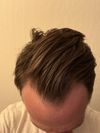community Has been on minoxidil for 5 years. Microneedling for 4 weeks no results.
The user has used minoxidil for five years and added microneedling for four weeks without seeing results. They are considering a hair transplant but are advised that hair loss will persist without a DHT blocker.
